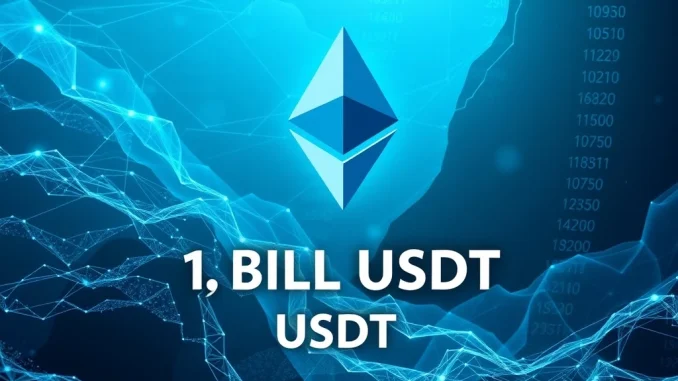
Get ready for a significant shift in the stablecoin landscape! Tether USDT, the world’s largest stablecoin, has once again made headlines with a massive issuance on the Ethereum network. This strategic move isn’t just about adding more tokens; it’s a calculated step to scale inventory and meet burgeoning market demand, pushing the total USDT supply on Ethereum past an astounding $160 billion. What does this mean for the broader crypto market and the future of decentralized finance?
Understanding Tether’s Latest 1 Billion USDT Issuance
On July 25, blockchain tracking service Whale Alert reported a fresh injection of 1 billion Tether USDT onto the Ethereum blockchain. This wasn’t a spontaneous event but a pre-authorized move, as confirmed by Tether CEO Paolo Ardoino. He clarified that these tokens are “authorized but unissued,” serving as vital inventory. Think of it as a reserve pool, ready to be deployed for future issuance requests and on-chain exchanges, ensuring liquidity and responsiveness to market needs.
This latest issuance follows a similar pattern from July 12, when Tether minted another 2 billion USDT on Ethereum in two consecutive one-billion-dollar tranches. This consistent, large-scale minting underscores Tether’s agile strategy to manage and expand its stablecoin presence. The goal is clear: to maintain its dominant position by ensuring sufficient supply to meet the ever-growing demand from traders, investors, and DeFi platforms globally. This rapid scaling of stablecoin issuance is a testament to Tether’s operational capacity and its proactive approach to market dynamics.
The Impact on Ethereum and the Broader USDT Supply
The implications of this Tether USDT issuance extend far beyond just increasing numbers. With this latest injection, the total USDT supply on the Ethereum network has surged past $160 billion. This remarkable figure highlights Ethereum’s critical role as a foundational layer for the stablecoin ecosystem. Despite the emergence of other blockchains, Ethereum continues to be a preferred network for high-volume transactions, evidenced by its recent record gas usage.
Tether’s decision to leverage Ethereum’s scalability for such significant issuances reinforces the network’s efficiency for large-scale operations. For the broader crypto market, a robust and liquid USDT supply is crucial. USDT acts as a benchmark for crypto valuations, providing a stable bridge between volatile digital assets and traditional fiat currencies. Its pervasive use in trading pairs, decentralized finance (DeFi) protocols, and cross-border remittances solidifies its function as a cornerstone of crypto liquidity. The continued growth of USDT on Ethereum signifies a strong, underlying demand for stable assets within the digital economy.
Navigating Stablecoin Regulation and Transparency Concerns
While Tether’s operational expansion is impressive, it inevitably brings increased scrutiny, particularly concerning stablecoin regulation and transparency. Analysts often point to Tether’s ability to mint large amounts of USDT without immediate regulatory intervention as both a strength and a point of contention. The company positions itself as a vital bridge between traditional finance and decentralized markets, facilitating seamless capital flows.
However, questions about the transparency of stablecoin reserves persist. Despite Tether’s assertions that its investments in over 120 companies—spanning Bitcoin mining, payments, and fintech—are funded entirely by operational profits, detailed reserve disclosures remain a point of criticism. This issue gained further traction after the U.S. Treasury froze $1.6 million in terrorism-linked USDT earlier this year, underscoring the risks of illicit activity tied to stablecoins. Tether maintains its compliance with existing frameworks, but such incidents highlight the ongoing challenge of balancing innovation with stringent regulatory oversight. The company’s approach to these challenges will be pivotal in maintaining institutional trust and its dominant market position.
What Does This Mean for the Crypto Market?
Market reactions to the July 25 minting of Tether USDT have remained relatively subdued, with USDT’s price stabilizing near $1.00 despite its record $162.64 billion market capitalization. This stability indicates strong market confidence in USDT’s peg, even amidst significant supply growth. The robust demand for USDT across various sectors, including DeFi platforms, remittances, and trading pairs, reinforces its indispensable role.
Analysts, however, caution that sustained supply growth could strain confidence if reserves are not adequately diversified and transparently managed. For now, Tether’s dual focus on operational expansion and strategic investments positions it to benefit from both short-term market cycles and long-term blockchain adoption. The increasing USDT supply acts as a liquidity magnet, drawing more capital into the crypto ecosystem and facilitating greater trading volume across various assets. This continued demand underscores the stablecoin’s importance as a foundational element of the digital economy.
Tether’s latest 1 billion USDT issuance on Ethereum is more than just a number; it’s a strategic move that underscores the stablecoin’s critical role in the evolving crypto landscape. By expanding its inventory, Tether ensures liquidity and responsiveness to market demand, solidifying Ethereum’s position as a key network for stablecoin operations. While questions about transparency and regulatory compliance remain pertinent, Tether’s proactive approach to scaling and its strategic investments position it to continue influencing the crypto market significantly. As the digital economy matures, the balance between innovation, robust supply, and regulatory adherence will define the trajectory of leading stablecoins like USDT.
Frequently Asked Questions (FAQs)
Q1: Why did Tether issue another 1 billion USDT on Ethereum?
A1: Tether issued an additional 1 billion USDT on the Ethereum network primarily for “inventory scaling.” This means the tokens are pre-authorized but unissued, serving as a reserve to meet future market demand, facilitate on-chain exchanges, and ensure sufficient liquidity.
Q2: How much USDT is now on the Ethereum network?
A2: Following this latest issuance, the total supply of USDT on the Ethereum network has now exceeded $160 billion, highlighting Ethereum’s continued importance as a primary blockchain for stablecoin operations.
Q3: What is the significance of Tether’s rapid stablecoin issuance?
A3: Tether’s rapid issuance highlights its capacity to respond swiftly to market demand for stablecoins. It ensures ample liquidity for trading, DeFi activities, and remittances, reinforcing USDT’s role as a critical benchmark and bridge between traditional finance and the crypto market.
Q4: Are there concerns about Tether’s transparency and regulation?
A4: Yes, questions persist regarding the transparency of Tether’s reserves, despite their claims of investments funded by operational profits. Regulatory scrutiny is also increasing, especially after incidents like the freezing of terrorism-linked USDT funds, emphasizing the ongoing need for clearer regulatory frameworks and compliance.
Q5: How does this issuance affect the overall crypto market?
A5: While the immediate market reaction to the latest minting was subdued, a robust USDT supply provides essential liquidity for the broader crypto market. It supports trading pairs, facilitates DeFi growth, and reinforces USDT’s function as a stable asset, though analysts caution about the need for transparent reserve management.



